TP-Link RE455 Manual

User Guide
AC1750 Wi-Fi Range Extender
RE455
REV1.0.0 1910012724
Contents |
|
About This Guide.......................................................................................................... |
1 |
Chapter 1. Get to Know About Your Extender . . . . . . . . . . . . . . . . . . . . . . . . 2
1. 1. Product Overview . . . . . . . . . . . . . . . . . . . . . . . . . . . . . . . . . . . . . . . . . . . . . . . . . . . . . . . . . . . .3 1. 2. Appearance . . . . . . . . . . . . . . . . . . . . . . . . . . . . . . . . . . . . . . . . . . . . . . . . . . . . . . . . . . . . . . . . . .3 1. 2. 1.LED Explanation . . . . . . . . . . . . . . . . . . . . . . . . . . . . . . . . . . . . . . . . . . . . . . . . . . . . . . .4 1. 2. 2.Port and Button Description . . . . . . . . . . . . . . . . . . . . . . . . . . . . . . . . . . . . . . . . . . .4
Chapter 2. Set Up Internet Connection. . . . . . . . . . . . . . . . . . . . . . . . . . . . . . . 5
2. 1. Quick Setup. . . . . . . . . . . . . . . . . . . . . . . . . . . . . . . . . . . . . . . . . . . . . . . . . . . . . . . . . . . . . . . . . .6 2. 1. 1.Method 1: Via a Web Browser . . . . . . . . . . . . . . . . . . . . . . . . . . . . . . . . . . . . . . . . . .6 2. 1. 2.Method 2: Via the TP-Link Tether App . . . . . . . . . . . . . . . . . . . . . . . . . . . . . . . . . .9 2. 1. 3.Method 3: Via the WPS Button . . . . . . . . . . . . . . . . . . . . . . . . . . . . . . . . . . . . . . . 10
2. 2. Position Your Extender . . . . . . . . . . . . . . . . . . . . . . . . . . . . . . . . . . . . . . . . . . . . . . . . . . . . . 11
Chapter 3. Customize Your Network . . . . . . . . . . . . . . . . . . . . . . . . . . . . . . . . 12
3. 1. Check Internet Status . . . . . . . . . . . . . . . . . . . . . . . . . . . . . . . . . . . . . . . . . . . . . . . . . . . . . . 13 3. 2. Configure Wireless Network . . . . . . . . . . . . . . . . . . . . . . . . . . . . . . . . . . . . . . . . . . . . . . . . 14 3. 3. Change LAN Settings . . . . . . . . . . . . . . . . . . . . . . . . . . . . . . . . . . . . . . . . . . . . . . . . . . . . . . 15 3. 4. Specify DHCP Server Settings . . . . . . . . . . . . . . . . . . . . . . . . . . . . . . . . . . . . . . . . . . . . . 16 3. 5. Adjust Wi-Fi Coverage. . . . . . . . . . . . . . . . . . . . . . . . . . . . . . . . . . . . . . . . . . . . . . . . . . . . . . 17 3. 6. Set Access Control. . . . . . . . . . . . . . . . . . . . . . . . . . . . . . . . . . . . . . . . . . . . . . . . . . . . . . . . . 18 3. 7. Set High Speed Mode . . . . . . . . . . . . . . . . . . . . . . . . . . . . . . . . . . . . . . . . . . . . . . . . . . . . . . 20
Chapter 4. More Features of Your Extender . . . . . . . . . . . . . . . . . . . . . . . . . 22
4. 1. Use Your Extender as a Wireless Adapter . . . . . . . . . . . . . . . . . . . . . . . . . . . . . . . . . . . 23 4. 2. Transform Your Existing Wired Network to a Wireless One. . . . . . . . . . . . . . . . . . . 23 4. 2. 1.To Set Up the Extender as an Access Point . . . . . . . . . . . . . . . . . . . . . . . . . . . 23 4. 2. 2.To Connect Your Wireless Devices to the Extender via WPS . . . . . . . . . . 25
Chapter 5. Manage Your Extender . . . . . . . . . . . . . . . . . . . . . . . . . . . . . . . . . . 27
5. 1. Set System Time . . . . . . . . . . . . . . . . . . . . . . . . . . . . . . . . . . . . . . . . . . . . . . . . . . . . . . . . . . . 28 5. 2. Control LEDs. . . . . . . . . . . . . . . . . . . . . . . . . . . . . . . . . . . . . . . . . . . . . . . . . . . . . . . . . . . . . . . 28 5. 3. Set Power Schedule. . . . . . . . . . . . . . . . . . . . . . . . . . . . . . . . . . . . . . . . . . . . . . . . . . . . . . . . 29 5. 4. Upgrade the Firmware. . . . . . . . . . . . . . . . . . . . . . . . . . . . . . . . . . . . . . . . . . . . . . . . . . . . . . 30 5. 5. Backup and Restore Configuration Settings . . . . . . . . . . . . . . . . . . . . . . . . . . . . . . . . 31 5. 6. Change Login Password. . . . . . . . . . . . . . . . . . . . . . . . . . . . . . . . . . . . . . . . . . . . . . . . . . . . 32 5. 7. Check System Log . . . . . . . . . . . . . . . . . . . . . . . . . . . . . . . . . . . . . . . . . . . . . . . . . . . . . . . . . 32
FAQ................................................................................................................................. |
34 |

About This Guide
This guide is a complement to Quick Installation Guide. The Quick Installation Guide provides instructions for quick internet setup, while this guide contains details of each
function and demonstrates how to configure them.
 Note: Features available in the range extender may vary by model and software version. The range extender availability may also vary by region or ISP. All images, steps, and descriptions in this guide are only examples and may not reflect your actual range extender experience.
Note: Features available in the range extender may vary by model and software version. The range extender availability may also vary by region or ISP. All images, steps, and descriptions in this guide are only examples and may not reflect your actual range extender experience.
Conventions
In this guide the following conventions are used:
Convention |
Description |
|
Underlined |
Underlined words or phrases are hyperlinks. You can click to redirect to a website or a |
|
specific section. |
||
|
||
Teal |
Contents to be emphasized and texts on the web page are in teal, including the menus, |
|
items, buttons, and so on. |
||
|
The menu structures to show the path to load the corresponding page. For example,
>Advanced > Wireless > MAC Filtering means the MAC Filtering function page is under the Wireless menu that is located in the Advanced tab.
|
Note: |
Ignoring this type of note might result in a malfunction or damage to the device. |
||
|
|
Tips: |
Indicates important information that helps you make better use of your device. |
|
|
|
|||
|
|
|||
symbols on the web |
• |
Click to edit the corresponding entry. |
||
page |
• |
Click to delete the corresponding entry. |
||
|
|
|
||
*Maximum wireless signal rates are the physical rates derived from IEEE Standard 802.11 specifications. Actual wireless data throughput and wireless coverage are not guaranteed and will vary as a result of 1) environmental factors, including building materials, physical objects, and obstacles, 2) network conditions, including local interference, volume and density of traffic, product location, network complexity, and network overhead, and 3) client limitations, including rated performance, location, connection, quality, and client condition.
More Info
The latest software, management app and utility are available from the Download Center at https://www.tp-link.com/support/download/.
The Quick Installation Guide can be found where you find this guide or inside the package of the access point.
Specifications can be found on the product page at https://www.tp-link.com.
A community is provided for you to discuss our products at https://community.tp-link.com.
Our Technical Support contact information can be found at the Contact Technical Support page at https://www.tp-link.com/support/.
1

Chapter 1
Get to Know About Your Extender
This chapter introduces what the extender can do and its appearance. It contains the following sections:
•Product Overview
•Appearance
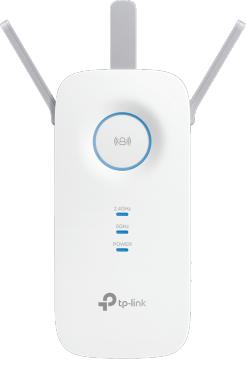
Chapter 1 |
Get to Know About Your Extender |
1. 1. Product Overview
Bring Dead Zones Back to Life
Tired of Wi-Fi “dead zones”? The TP-Link extender is connected to your router wirelessly, strengthening its signal and expanding its coverage into areas that could not otherwise be reached. The device also reduces signal interference to ensure reliable Wi-Fi coverage throughout your home or office.
Easy Installation & Quick Position
The extender works with any standard wireless router. Instantly connect the extender to a router by pressing the router’s WPS button (if available) followed by the extender’s WPS button. Alternatively, follow the Quick Setup instructions on the extender’s web management page.
Once the extender is connected to a router, you can relocate it to your preferred location with no further configuration required. The intelligent signal light can help to find the best location.
Easy Management with the TP-Link Tether App
Tether provides a simple, intuitive way to access and manage your extender with your smart devices.
1. 2. Appearance
3

Chapter 1 |
Get to Know About Your Extender |
1. 2. 1. LED Explanation
You can check the extender’s working status by following the LED Explanation table.
Name |
Status |
Indication |
|
|
Solid blue |
The extender is connected to your router’s wireless network |
|
|
and is in a suitable location. |
||
|
|
||
|
Solid red |
The extender is experiencing poor signal strength. Try |
|
(Signal) |
relocating it closer to your router. |
||
|
|||
|
Blinking |
WPS connection is in progress. |
|
|
Off |
No wireless connection is established. |
|
2.4GHz |
On/Off |
The extender is connected or not connected to the 2.4GHz |
|
wireless network of your host router. |
|||
|
|
||
5GHz |
On/Off |
The extender is connected or not connected to the 5GHz |
|
wireless network of your host router. |
|||
|
|
||
POWER |
On/Off |
The extender is on or off. |
|
Blinking |
The extender is starting up or firmware is being upgraded. |
||
|
1. 2. 2. Port and Button Description
Ports or Buttons |
Description |
|
|
|
Press the WPS button on your host router, and immediately press the |
||
WPS Button |
button on the extender for 1 second. The Signal LED |
of the extender |
|
should change to solid on, indicating successful WPS connection. |
|||
|
|||
Power Button |
Press for 1 second to turn on or off the extender. |
|
|
LED Button |
Press for 1 second to turn on or off all LEDs. |
|
|
Reset (Hole) |
Use a pin to press and hold for 1 second to reset the extender. |
||
Ethernet Port |
Connect your Ethernet-only device to the Ethernet port of the extender to join |
||
the network. |
|
||
|
|
||
4

Chapter 2
Set Up Internet Connection
This chapter introduces how to boost your host wireless coverage. Please follow the step-by-step instructions to set up the internet connection.
It contains the following sections:
•Quick Setup
•Position Your Extender

Chapter 2 |
Set Up Internet Connection |
2. 1. Quick Setup
Power On
Plug the extender into an electrical outlet near your host router, and then wait until the
POWER LED is solid on.
 Note:
Note:
1.For safety, we suggest that you plug the extender in upright directions as shown below.
2.The operating temperature should be between 0°C and 40°C (32°F - 104°F).
Connect and Extend
There are three ways to connect to and extend the host network: via a web browser, via the TP-Link Tether app, or via the WPS button.
2. 1. 1. Method 1: Via a Web Browser
1.Connect your computer to the extender via your Ethernet cable, or connect wirelessly as follows:
•For Windows Users
1 ) Unplug the Ethernet cable from your computer (if any).
2 ) Click the Wi-Fi icon on the taskbar and connect to the extender’s wireless network: TP-Link_Extender_2.4GHz or TP-Link_Extender_5GHz.
TP-Link_Extender_2.4GHz
TP-Link_Extender_5GHz
√ Connect automatically
6
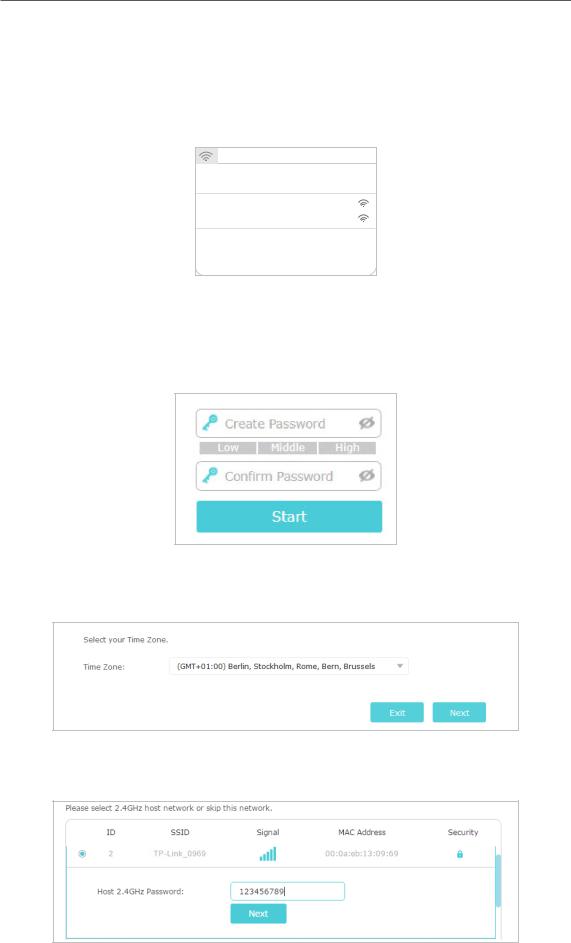
Chapter 2 Set Up Internet Connection
• For Mac OS X Users
1 ) Unplug the Ethernet cable from your computer (if any).
2 ) Click the Wi-Fi icon in the top right corner of the screen, and connect to the extender’s network: TP-Link_Extender_2.4GHz or TP-Link_Extender_5GHz.
Wi-Fi: On
Turn Wi-Fi O
TP-Link_Extender_2.4GHz
TP-Link_Extender_5GHz
Join Other Network...
Create Network...
Open Network Preferences...
2.Follow the instructions of the Quick Setup Wizard to connect the extender to your host router.
1) Launch a web browser, enter http://tplinkrepeater.net or http://192.168.0.254 in the address bar, and then create a password for future logins, and click Start.
 Tips: If the login window does not appear, please refer to FAQ.
Tips: If the login window does not appear, please refer to FAQ.
2 ) Select your time zone, and click Next.
3 ) Select your host router’s 2.4GHz SSID (network name), enter its password (NOT the password you just created for management), and click Next.
7
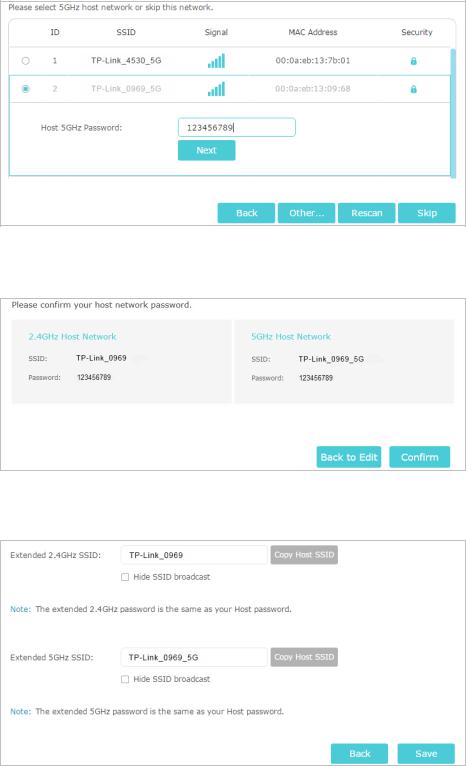
Chapter 2 |
Set Up Internet Connection |
4 ) Select your host router’s 5GHz SSID (network name), enter its password (NOT the password you just created for management), and click Next.
 Tips: If your host router does not support 5GHz wireless network, please click Skip to continue.
Tips: If your host router does not support 5GHz wireless network, please click Skip to continue.
5 ) Confirm your host network password.
6 ) Either keep the default SSIDs (network names) or customize them for the extended networks, and then click Save.
7 ) Enjoy! Connect to the extended network and enjoy the internet. Both extended networks share the same wireless passwords as those of your host networks,
8
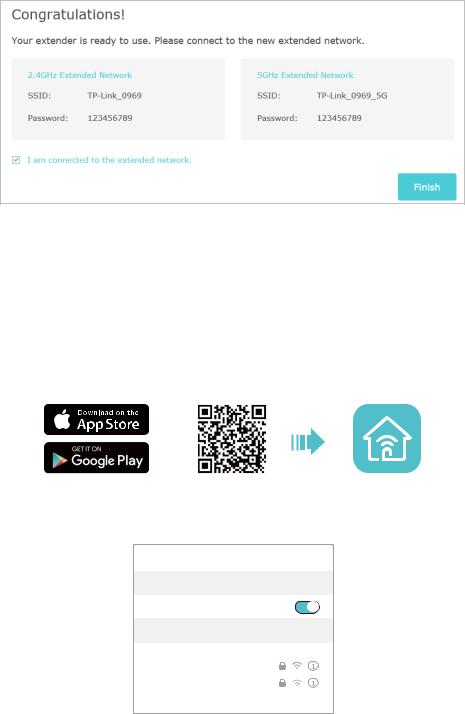
Chapter 2 |
Set Up Internet Connection |
but may have different network names if you have customized the SSIDs during the configuration.
 Note:
Note:
Since the performance of the extended network will be affected by the distance between the extender and the host router, we highly recommend you to relocate your extender referring to Position Your Extender.
2. 1. 2. Method 2: Via the TP-Link Tether App
1.Launch the Apple App Store or Google Play Store and search TP-Link Tether or simply scan the QR code to download and install the app.
OR
2.Go to Wi-Fi Settings and connect your device to the extender’s wireless network: TP-Link_Extender_2.4GHz or TP-Link_Extender_5GHz.
<Settings Wi-Fi
Wi-Fi
CHOOSE A NETWORK...
TP-Link_Extender_2.4GHz
TP-Link_Extender_5GHz
Other...
3. Launch Tether and select your extender from the Local Device list.
9
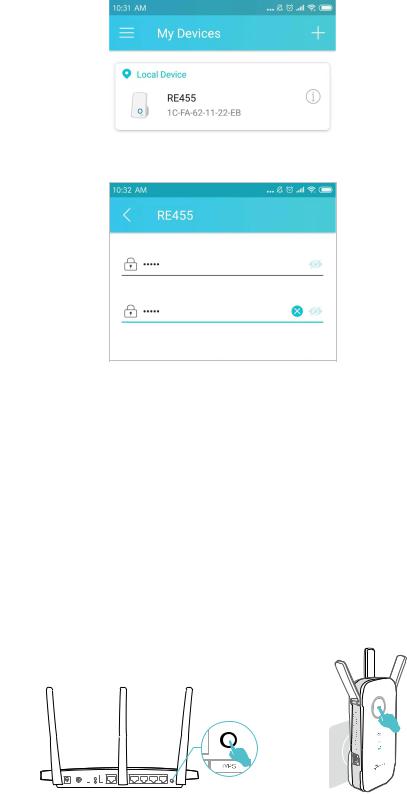
Chapter 2 |
|
Set Up Internet Connection |
|
|
|
|
|
|
4. Create a password for future logins and click Create.
5. Follow the on-screen instructions to complete the configuration.
 Tips: You can manage your extender via Tether, such as controlling LEDs, sharing passwords of your networks and blocking devices.
Tips: You can manage your extender via Tether, such as controlling LEDs, sharing passwords of your networks and blocking devices.
 Note: Since the performance of the extended network will be affected by the distance between the extender and host router, we recommend that you relocate your extender by referring to Position Your Extender.
Note: Since the performance of the extended network will be affected by the distance between the extender and host router, we recommend that you relocate your extender by referring to Position Your Extender.
2. 1. 3. Method 3: Via the WPS Button
Use this way if your router has a WPS button. The button might look like one of these:




 .
.
1.Press the WPS button on your host router, and then press the WPS button on the extender for 1 second within 2 minutes.
 Note:
Note:
For more information about using WPS button on your host router, please refer to the router manufacturer’s user guide.
10

Chapter 2 |
Set Up Internet Connection |
2.Wait until the Signal LED 

 changes to solid on, which indicates that the WPS connection is successful.
changes to solid on, which indicates that the WPS connection is successful.
3.Enjoy! Connect to the extended network and enjoy the Internet. Both extended networks share the same SSIDs (network names) and passwords as those of your host networks.
 Note:
Note:
•If the extender connects to a dual-band router but only the 2.4GHz or 5GHz LED is on, repeat Step 1 and 2 to connect to the other band.
•If the WPS method fails, or if you want to customize the extended network name, refer to Method 1: Via a Web Browser or Method 2: Via the TP-Link Tether App.
•Since the performance of the extended networks will be affected by the distance between the extender and the host router, we highly recommend you to relocate your extender by referring to Position Your Extender.
2. 2. Position Your Extender
Please follow the instructions below to achieve optimal performance of the extender.
1.Plug the extender into an electrical outlet between your host router and the Wi-Fi “dead“ zone. The location you choose must be within the range of your existing host network.
2.Wait until the Signal LED

 is lit and solid blue. If it’s not, relocate the extender closer to the host router to achieve better signal quality.
is lit and solid blue. If it’s not, relocate the extender closer to the host router to achieve better signal quality.
|
Host Network |
Extended Network |
|
Router |
Ideal extender Placement |
Device |
|
|
Blue: |
Red: |
|
|
Ideal location |
Too far from router |
|
 Tips:
Tips:
To minimize signal interference, please choose a location which is far away from Bluetooth devices and other household electronic devices, such as cordless phones, microwave ovens and baby monitors.
11

Chapter 3
Customize Your Network
This chapter guides you on how to configure network settings that are available for this extender.
It contains the following sections:
•Check Internet Status
•Configure Wireless Network
•Change LAN Settings
•Specify DHCP Server Settings
•Adjust Wi-Fi Coverage
•Set Access Control
•Set High Speed Mode
